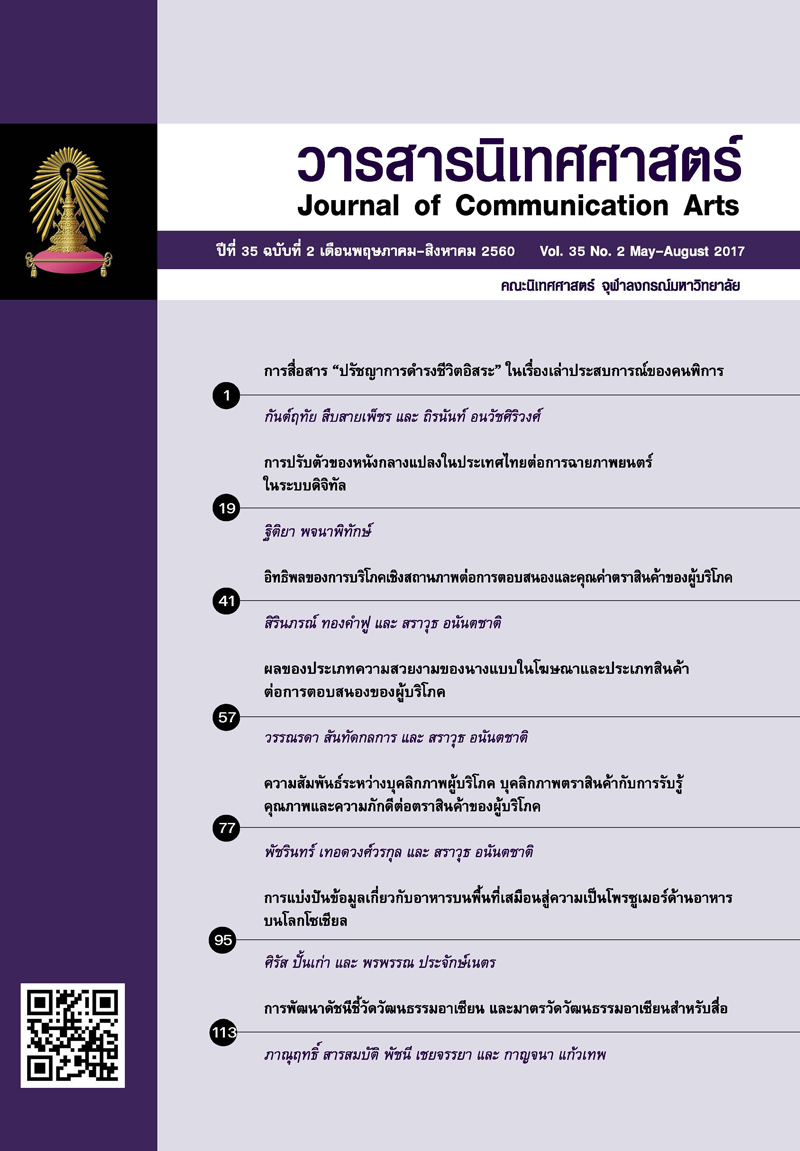อิทธิพลของการบริโภคเชิงสถานภาพต่อการตอบสนองและคุณค่าตราสินค้าของผู้บริโภค
Main Article Content
Abstract
The objectives of this research were to study: (1) the relationships of status consumption to brand responses which composed of self-image congruency, involvement, price sensitivity and brand consciousness, (2) the relationship of status consumption to brand equity and (3) the relationships of brand responses to brand equity. A self-administered questionnaire was used to collect survey data from 400 first jobber consumers aged 22-29 years old in Bangkok. The findings significantly showed that there were positive correlations between status consumption and self-image congruency, involvement, brand consciousness and brand equity. However there was negative correlation between status consumption and price sensitivity. In addition, for self-image congruency, involvement and brand consciousness were significantly and positively correlated with brand equity. Meanwhile, there was negative correlation between price sensitivity and brand equity.
Article Details
References
Assael, H. (2004). Consumer behavior: A strategic approach. Boston, MA: Houghton Mifflin.
Amine, A. (1998). Consumers' true brand loyalty: The central role of commitment. Journal of Strategic Marketing, 6(4), 305-319.
Day, G. S. (1969). A two-dimensional concept of brand loyalty. Journal of Advertising Research, 9(3), 29-36.
Deeter-Schmelz, D. R., Moore, J. N., & Goebel, D. J. (2000). Prestige clothing shopping by consumer: A confirmatory assessment and refinement of the precon scale with managerial implications. Journal of Marketing Theory and Practice, 8(4), 43-58.
Eastman, J. K., & Eastman, K. L. (2011). Perceptions of status consumption and the economy. Journal of Business & Economics Research, 9(7), 9-19.
Eastman, J. K., Goldsmith, R. E., & Flynn, L. R. (1999). Status consumption in consumer behavior: Scale development and validation. Journal of Marketing Theory and Practice, 7(3), 41-51.
Eastman, J. K., & Liu, J. (2012). The impact of generational cohorts on status consumption: An exploratory look at generational cohort and demographics on status consumption. Journal of Consumer Marketing, 29(2), 93-102.
Farquhar, P. H. (1990). Managing brand equity. Journal of Advertising Research, 30(4), 7-12.
Goldsmith, R. E., Flynn, L. R., & Clark, R. A. (2012). Materialistic, brand engaged and status consuming consumers and clothing behaviors. Journal of Fashion Marketing and Management, 16(1), 102-119.
Goldsmith, R. E., & Newell, S. J. (1997). Innovativeness and price sensitivity: Managerial, theoretical and methodological issues. Journal of Product and Brand Management, 6(3), 163-174.
Goldsmith, R. E., Flynn, L. R., & Kim, D. (2010). Status consumption and price sensitivity. Journal of Marketing Theory and Practice, 18(4), 323-338.
Hawkins, D. I., & Mothersbaugh, D. L. (2010). Consumer behavior: Building marketing strategy (11th ed.). NY: McGraw-Hill.
Husic, M., & Cicic, M. (2009). Luxury consumption factors. Journal of Fashion Marketing and Management, 13(2), 231-245.
Kapferer, J. N., & Laurent, G. (1988). Consumer brand sensitivity: A key to measuring and managing brand equity. In L. Leuthesser (Ed.). Defining, measuring, and managing brand equity: A conference summary (Report no. 88-104, pp. 12-15). Cambridge, MA: Marketing Science Institute.
Keller, K. L. (2008). Strategic brand management: Building, measuring, and managing brand equity (3rd ed.). Upper Saddle River: Pearson Prentice Hall.
Kilsheimer, J.C. (1993). Status consumption: The development and status implications of a scale measuring the motivation to consumers for status (Doctoral's thesis). Available from ProQuest Dissertations and Theses database. (UMI No. 9317645)
Lachance, M. J., Beaudoin, P., & Robitaille, J. (2003). Adolescents' brand sensitivity in apparel: Influence of three socialization agents. International Journal of Consumer Studies, 27(1), 47-57.
Laurent, G. & Kapferer, J. -N., (1985) Measuring consumer involvement profiles. Journal of Marketing Research, 22(1), 41-53.
Liu, F., Li, J., Mizerski, D., & Soh, H. (2012). Self-congruity, brand attitude, and brand loyalty: A study on luxury brands. European Journal of Marketing, 46(7/8), 922-937.
Mowen, J. C., & Minor, M. (1998). Consumer behavior (5th ed.). Upper Saddle River, NJ: Prentice Hall.
Netemeyer, R. G., Krishnan, B., Pulling, C., Wang, G. P., Yagci, M., Dean, D., Ricks, J., & Wirth, F. (2004). Developing and validating measures of facets of customer-based brand equity. Journal of Business Research, 57(2), 209-224.
O'Cass, A., & Choy, E. (2008). Studying Chinese generation Y consumers' involvement in fashion clothing and perceived brand status. Journal of Product & Brand Management, 17(5), 341-352.
O'Cass, A., & Frost, H. (2002). Status brands: Examining the effects of non-product-related brand associations on status and conspicuous consumption. Journal of Product & Brand Management, 11(2), 67-88.
O'Cass, A., & McEwen, H. (2004). Exploring consumer status and conspicuous consumption. Journal of Consumer Behavior, 4(1), 25-39.
Onkvisit, S., & Shaw, J. (1987). Self-concept and image congruence: Some research and managerial implications. The Journal of Consumer Marketing, 4(1), 13-23.
Phau, I., & Cheong, E. (2009). How young adult consumers evaluate diffusion brands: Effects of brand loyalty and status consumption. Journal of International Consumer Marketing, 21(2), 109-123.
Roy, R., & Chau, R. (2011). Consumer-based brand equity and status-seeking motivation for a global versus local brand. Asia Pacific Journal of Marketing and Logistics, 23(3), 270-284.
Schiffman, L. G., & Kanuk, L. L. (2010). Consumer behavior (10th ed.). Upper Saddle River, NJ: Prentice Hall.
Shukla, P. (2010). Status consumption in cross-national context. International Marketing Review, 27(1), 108-129.
Solomon, M. R. (2011). Consumer behavior: Buying, having, and being (9th ed.). Upper Saddle River, N.J: Prentice Hall.
Sproles, G. B., & Kendall, E. L. (1986). A methodology for profiling consumers' decision-making styles. The Journal of Consumer Affairs, 20(2), 267-279.
Stolley, K. S. (2005). The basic of sociology. Westport, CT: Greenwood Press.
Vigneron, F., & Johnson, L. W. (1999). A review and a conceptual framework of prestige-seeking consumer behavior. Academy of Marketing Science Review. Retrieved August 25, 2012, from http://www.amsreview.org/articles/vigneron01-1999.pdf
Yasin, B. (2009). The Role of Gender on Turkish Consumers’ Decision Making Styles, Advances in Consumer Research, 8(1), 301-308.


